Soil testing and soil test interpretation
 Nutrient applications to sugarcane crops in regions designated as reef catchments (from a Great Barrier Reef Water Quality Improvement Plan point of view) are subject to Government regulation. Compliance is the responsibility of the grower/land manager, for soil testing and in not exceeding maximum allowable application rate of nutrient. Compliance inspections and audits are conducted by Qld Department of Environment and Science.
Nutrient applications to sugarcane crops in regions designated as reef catchments (from a Great Barrier Reef Water Quality Improvement Plan point of view) are subject to Government regulation. Compliance is the responsibility of the grower/land manager, for soil testing and in not exceeding maximum allowable application rate of nutrient. Compliance inspections and audits are conducted by Qld Department of Environment and Science.
Sugarcane crop nutrition is supported by industry-developed and scientifically based decision support system called Six-Easy-Steps (6ES), managed by Sugar Research Australia. This is a framework to guide in the interpretation of soil tests taken from sugarcane fields. Most soil analysis laboratories will now routinely provide results which include 6ES interpretation.
While intended as a guideline, 6ES has more or less been mandated in the Qld Government regulations.
All interpretations and recommendations to growers should abide with 6ES. Fertiliser Australia runs the FertCare Level C Accredited Advisor scheme to provide a quality benchmark for professional agronomists and fertiliser suppliers to the end user. Fertcare Level C is complemented by Nutrient Advantage Advisor delivered by IncitecPivot Ltd.
Laboratories should be National Association of Testing Authorities (NATA) accredited, for process quality control. Additionally, best practice for Laboratories servicing the agricultural sector is to subscribe to the Australasian Soil and Plant Analysis Council (ASPAC) certification scheme, where routine comparisons of analytic results are run to assist laboratories in the uniform application of standard soil test methods.
ASPAC certification is voluntary and is specific to each analyte. The lab might be certified for a select range of analytic methods. Certification has to be maintained through regular participation in testing rounds.
©TropCrop Pty Ltd

